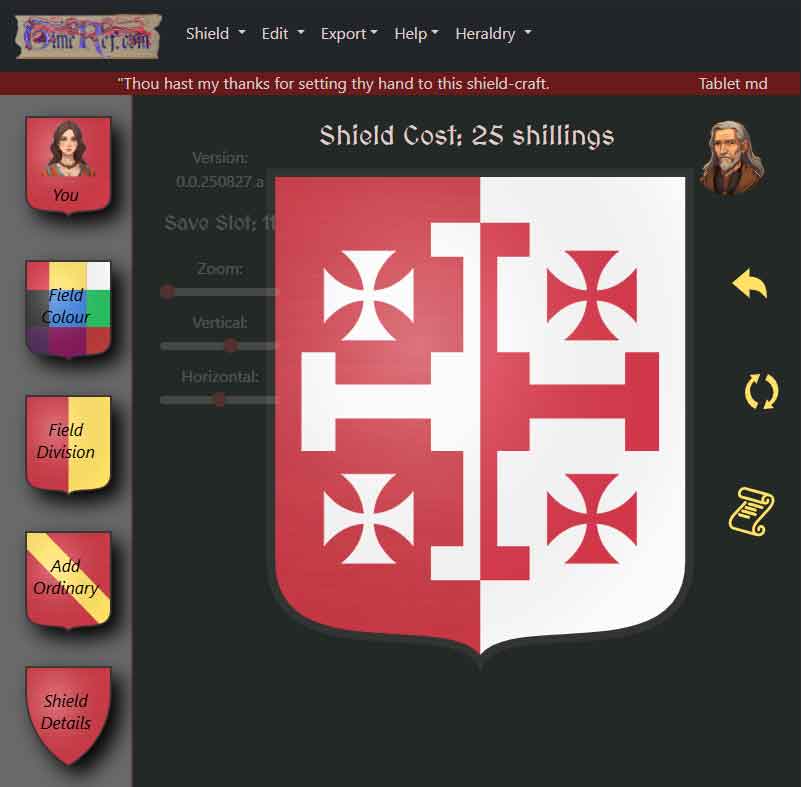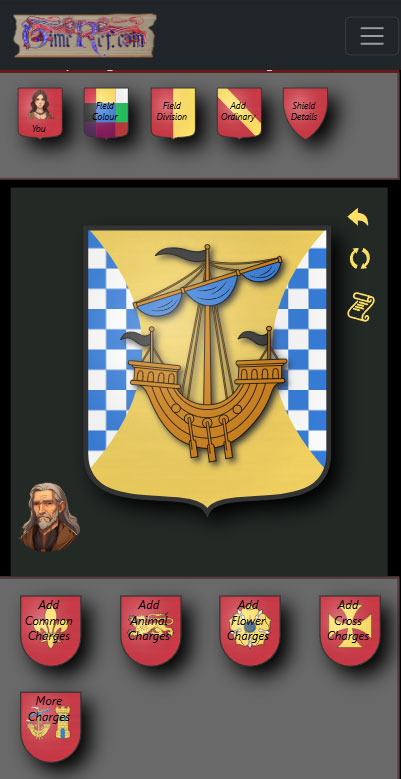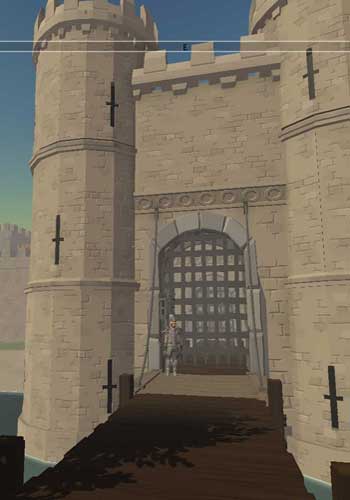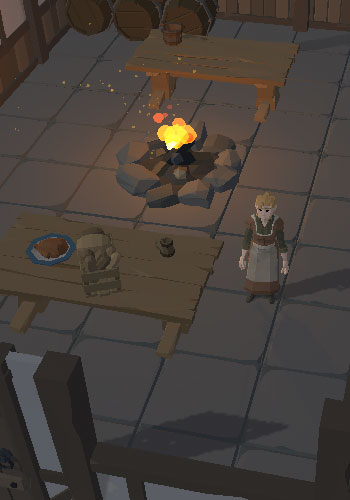 urham Cathedral is built on a peninsular carved out by a sudden turn of the river Wear. The body of Cuthbert was brought to Durham in 995 a hundred years after being moved from Lindisfarne where it was in danger of destruction by the Danes. The Normans took control of the cathedral and a castle was built nearby to the north. The building work of the present cathedral was begun around 1093 and continued until 1133. It is the best example of Romanesque architecure in Europe. When the Lady Chapel was added in the middle of the twelfth century its usual location at the east of the church was not suitable due to problems with the foundations. The chapel was built instead at the west end of the church and is known as the Galilee Chapel. The west end of the cathedral has no entrance being so close the steep sides of the peninsular so the main entrances are through the north and south sides. At the east end of the cathedral is the chapel of the Nine Altars, the construction of which began in around 1242. This was built in the eleventh century and houses the shrine of St. Cuthbert. Cuthbert is still buried here.
urham Cathedral is built on a peninsular carved out by a sudden turn of the river Wear. The body of Cuthbert was brought to Durham in 995 a hundred years after being moved from Lindisfarne where it was in danger of destruction by the Danes. The Normans took control of the cathedral and a castle was built nearby to the north. The building work of the present cathedral was begun around 1093 and continued until 1133. It is the best example of Romanesque architecure in Europe. When the Lady Chapel was added in the middle of the twelfth century its usual location at the east of the church was not suitable due to problems with the foundations. The chapel was built instead at the west end of the church and is known as the Galilee Chapel. The west end of the cathedral has no entrance being so close the steep sides of the peninsular so the main entrances are through the north and south sides. At the east end of the cathedral is the chapel of the Nine Altars, the construction of which began in around 1242. This was built in the eleventh century and houses the shrine of St. Cuthbert. Cuthbert is still buried here.| County | TBC | Categories | |
| Remains | Excellent remains | Access | Only open at certain times |
| Location | 54.7743,-1.5779 (Google Maps) ///safety.estate.ranch | Directions | Directions via Google Maps |
| County |
TBC |
| Categories |
| Remains |
Excellent remains |
| Access |
Only open at certain times |
| Location |
| 54.7743,-1.5779 ///safety.estate.ranch |
| Directions |
| Directions via Google Maps |
 urham Cathedral is built on a peninsular carved out by a sudden turn of the river Wear. The body of Cuthbert was brought to Durham in 995 a hundred years after being moved from Lindisfarne where it was in danger of destruction by the Danes. The Normans took control of the cathedral and a castle was built nearby to the north. The building work of the present cathedral was begun around 1093 and continued until 1133. It is the best example of Romanesque architecure in Europe. When the Lady Chapel was added in the middle of the twelfth century its usual location at the east of the church was not suitable due to problems with the foundations. The chapel was built instead at the west end of the church and is known as the Galilee Chapel. The west end of the cathedral has no entrance being so close the steep sides of the peninsular so the main entrances are through the north and south sides. At the east end of the cathedral is the chapel of the Nine Altars, the construction of which began in around 1242. This was built in the eleventh century and houses the shrine of St. Cuthbert. Cuthbert is still buried here.
urham Cathedral is built on a peninsular carved out by a sudden turn of the river Wear. The body of Cuthbert was brought to Durham in 995 a hundred years after being moved from Lindisfarne where it was in danger of destruction by the Danes. The Normans took control of the cathedral and a castle was built nearby to the north. The building work of the present cathedral was begun around 1093 and continued until 1133. It is the best example of Romanesque architecure in Europe. When the Lady Chapel was added in the middle of the twelfth century its usual location at the east of the church was not suitable due to problems with the foundations. The chapel was built instead at the west end of the church and is known as the Galilee Chapel. The west end of the cathedral has no entrance being so close the steep sides of the peninsular so the main entrances are through the north and south sides. At the east end of the cathedral is the chapel of the Nine Altars, the construction of which began in around 1242. This was built in the eleventh century and houses the shrine of St. Cuthbert. Cuthbert is still buried here.Location
See Also
People
Related Information
Related Maps
Related Episodes
Viking Invasions (click here)
Dimensions of main church
| Dimensions: General | Feet | Inches |
| Total Length | 470 | 0 |
| West wall to east window | 410 | 0 |
| Length of nave | 205 | 0 |
| Height of nave | 72 | 0 |
| Width of nave | 81 | 0 |
| Transept | 165 | 0 |
| Length of choir | 133 | 0 |
| Height of central tower | 218 | 0 |
| Height of western towers | 144 | 0 |
| Area | 44400 sq.feet | |
Timeline
999
...
Durham Cathedral consecrated
Bishop Aldhun, the first Bishop of Durham, consecrated a cathedral at the location where the remains of St. Cuthbert had been relocated to. The remains were at Lindisfarne and were moved because of the danger of Viking raids. [1]
1093
...
Durham Cathedral begun
Durham Cathedral was the first building in Western Europe with ribbed vaulting in the ceiling. [2]
1099
(to 1128)
Nave at Durham constructed
Construction of the nave at Durham Cathedral began in 1099 and lasted until 1128. [3]
1099
...
Flambard is made Bishop of Durham
Ranulf Flambard is made the Bishop of Durham by William Rufus.
1128
(to 1133)
The nave at Durham Cathedral is vaulted
Work on the nave vaulting at Durham Cathedral took place from 1128 until 1133. [3]
1133
(to 1140)
Durham Cathedral Chapter house
Construction of the Chapter house at Durham Cathedral was begun in 1133 and continued until 1140. [3]
1170
(to 1175)
The Galilee porch at Durham is built
The Galilee porch on the West front of Durham Cathedral was built between 1170 and 1175. [3]
1242
(to 1280)
Chapel of the Nine Altars
The Chapel of the Nine Altars in built on the east end of Durham Cathedral between 1242 and 1280. [3]
1523
...
Wolsey become Bishop of Durham
As Bishop of Durham, Thomas Wolsey's power and influence inreased greatly. [4]
3D Virtual Reconstructions
Transport yourself back up to a thousand years and explore historical buildings as they may have appeared in the past. Built using the popular game development tool Unity 3D, these reconstructions will run in the most of the popular web browsers on your desktop or laptop computer.
Page Navigation
Selection of references used:
- 1: T. Francis Bumpus, The Cathedrals of England and Wales, 1934
- 2: Alan & Veronica Palmer, Pimlico Chronology of Britsh History, ISBN:0-7126-7331-8
- 3: John Harvey, English Cathedrals, 1961, Batsford (1961)
- 4: William Henry Derbyshire, A history of Dunstable
Location
See Also
People
Related Information
Related Maps
Explore the White Tower
Explore all four floors of the White Tower at the Tower of London using the Unity 3d game engine.
A Medieval Mystery
There appear to be some strange connections between the fourteenth century Old Wardour Castle and ancient stone circle Stonehenge.

1: Location
Old Wardour Castle appears to be aligned to ancient sites in the Stonehenge landscape.
2: Alignment
Stonehenge is aligned to the Summer Solstice. Old Wardour has a very similar alignment.
3: Size
Could the builders of Old Wardour used mesaurements from Stonehenge to layout the geometrical keep?
Learn More














